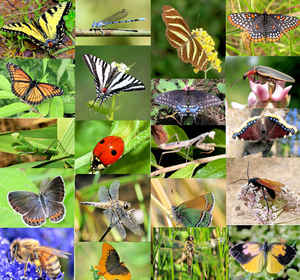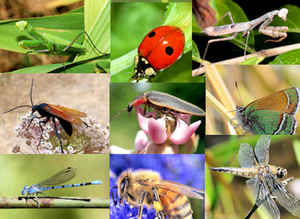
Virginia Symbols
Virginia State Insect
Tiger Swallowtail Butterfly

(Papilio glaucous Linne)
Adopted in 1991.
In 1976, a bill was introduced to adopt a Chinese mantid as Virginia's official state insect. Entomologist Michael Kosztarab (Founding Director of the Virginia Museum of Natural History at Virginia Tech) countered by proposing a native species, the tiger swallowtail butterfly, (Papilio glaucous Linne.) The Senate chose the tiger swallowtail, but the House sided with the praying mantis, and the butterfly bill fluttered to the floor in a deadlock.
On June 13, 1987, the US Postal Service issued a sheet of 50 different stamps commemorating American wildlife.
In 1991, Kosztarab allied with the Virginia Federation of Garden Clubs, Inc. and submitted a new swallowtail bill. Why was the tiger swallowtail chosen over so many other native insects? Well, there were several reasons:
• The tiger swallowtail was the first North American insect to be
described scientifically (by the Swedish biologist, Linnaeus).
• The specimens Linnaeus examined came from Virginia.
• The tiger swallowtail is harmless, colorful, and graceful.
• It is widespread and active in Virginia from April to late October.
• Adults pollinate flowers.
• The tiger swallowtail symbolizes the fragile environment. (Several butterfly species have been declining in Virgnia.)
The butterfly bill passed, and a new Virginia symbol flitted onto Virginia's roster of state symbols.
Virginia State Insect: Tiger Swallowtail Butterfly

The eastern tiger swallowtail, (Papilio glaucus,) one of the most common and widely distributed swallowtail butterflies in the eastern United States, has a wingspan that can reach 5 inches. The males' bright yellow wings have four black bands on the front wings, and a long black tail on each hind wing, and are easily identified. The first rendering of this species was of an adult male, drawn in 1587 by John White, commander of Sir Walter Raleigh's third expedition to North America. Some females, particularly those in the North, are black, with some blue interlaced with black bands on the hind wings. These females superficially resemble the poisonous blue pipevine swallowtail, Battus philenor.
Characteristics of Virginia Tiger Swallowtail Butterfly
Life Cycle
- Two flights generally occur in the north, and three or four flights take place as far south as Florida.
- Male swallowtails fly at treetop level and descend to mate with lower-flying females.
- Females lay single, globular greenish-yellow eggs on the surface of leaves, and the young larvae that result are dark and resemble bird droppings.
- The two-inch-long mature larva or caterpillar is bright green and swollen in front, with false black and orange eyespots. These larvae spin a silk "mat" on the leaf, which curls the edges of the leaf somewhat.
- Larvae feed until they are full-grown, then develop into a dark brown or greenish brown caterpillar and descend the trunk of the tree and pupate on the ground, creating a dark stick-like chrysalis in which they overwinter.
- The pupa is light brown with a dark brown or black lateral stripe and dark brown dorsal band.
Habitat
Virginia's state insect is the Eastern Tiger Swallowtail and one of our biggest butterflies. Tiger Swallowtails are commonly found in deciduous woodlands and along their borders, including parks and neighborhoods, where they feed on the nectar of wild and garden flowers from Spring through Fall.
The tiger swallowtail is widely distributed from New England west through the southern Great Lakes area (along Merriam's "transition life zone") through most of the Great Plains states and south to Texas and Florida. In the transition zone, the eastern tiger swallowtail is sympatric with the closely related Canadian tiger swallowtail, Papilio canadensis (until recently, considered a subspecies of P. glaucus).
Virginia Law
The law designating the Tiger Swallowtail Butterfly as the official Virginia state butterfly is found in the Code of Virginia, Title 7.1, Chapter 5, Section 7.1-340.5.
§ 7.1-40.5. Official insect.
The Tiger Swallowtail Butterfly (Papilio glaucus Linne) is hereby designated the official insect of the Commonwealth.
(1991, c. 575.) Commonwealth
Taxonomic Hierarchy: Eastern Tiger Swallowtail
Kingdom: Animalia (Animals)
Phylum: Arthropoda (Arthropods)
Subphylum: Hexapoda (Hexapods)
Class: Insecta (Insects)
Order: Lepidoptera (Butterflies and Moths)
Superfamily: Papilionoidea (Butterflies and Skippers)
Family: Papilionidae (Swallowtails, Parnassians)
Subfamily: Papilioninae
Tribe: Papilionini (Fluted Swallowtails)
Genus: Papilio
Species; glaucus (Eastern Tiger Swallowtail)
Butterflies, and Bugs







